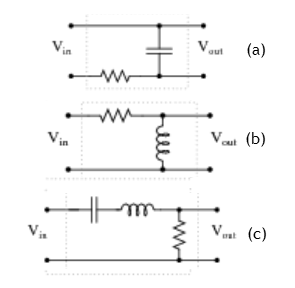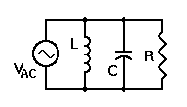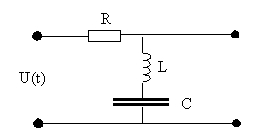RLC circuits (AC)
Problem:
A series RLC circuit is driven by a generator with an emf
amplitude of 80 V and a current amplitude of 1.25 A. The current leads the emf by
0.65 rad. What are the impedance and the resistance of the circuit?
Solution:
- Concepts:
AC circuits
- Reasoning:
We have a series RLC circuit and a AC generator, generating a sinusoidal
voltage.
- Details of the calculation:
In general:
V = IZ
Z = R + iωL + 1/(iωC)
= R + i(ωL - 1/(ωC))
= (R2 + (ωL - 1/(ωC))2)½exp(iφ)
φ = tan-1((ωL
- 1/(ωC))/R)
All that is needed for this problem:
Z = R + iX.
Given:
V = 80 V exp(iωt),
I = 1.25 A exp(i(ωt + 0.65)),
Z = V/I = 64 Ω
exp(-i0.65), R = 64 Ω cos(0.65) =
50.95 Ω.
Problem:
In the circuit below a 30 V (peak) AC source at 60 Hz is
connected to a 90 Ω
resistor, a 50 μF capacitor, and a 60 mH inductor
in series. Find the phase of the current through the circuit with respect to
the voltage across the source.

Solution:
- Concepts:
AC circuits
- Reasoning:
We are asked to analyze an AC
circuit.
- Details of the calculation:
V = IZ.
Z = R + iωL + 1/(iωC)
= [90 + i*22.6 - i*53)] Ω.
= [90 - i*30.4] Ω = 95 exp(iφ)
Ω with φ = -0.326.
I = V/Z = (30 V)/(95 exp(-i0.326)) Ω =
0.316 A exp(i0.326).
The peak value of the current is 0.316 A.
φI -
φV = 0.326. I(t) leads
V(t).
Problem:
For the circuits shown below, Vin = V0exp(iωt).
In terms of R L and C
find Vout and identify which type of filter each circuit
represents.

Solution:
- Concepts:
Filter circuits
- Reasoning:
We are asked to analyze 3 different AC filter circuits.
- Details of the calculation:
(a)
I
= Vin/(ZC + ZR), Vout
= IZC = VinZC/(ZC + ZR).
ZC/(ZC + ZR) = 1/(1 + iRωC)
= (1 - iRωC)/(1 + ω2R2C2) = [1/(1 +
ω2R2C2)½]e-iφ.
tanφ = RωC.
Vout = V0[1/(1
+
ω2R2C2)½]ei(ωt-φ).
Vout --> 0 as ω --> ∞, Vout --> V0
as ω --> 0, we have a low-pass filter.
(b)
I
= Vin/(ZL + ZR), Vout
= IZL = VinZL/(ZL + ZR).
ZL/(ZL + ZR) =
ωLexp(iπ/2)/(R + iωL) = exp(iφ)ωL/(R2 + (ωL)2)½.
Vout = V0[ωL/(R2 + (ωL)2)½]ei(ωt+φ).
Vout --> 0 as ω --> 0, Vout --> V0
as ω --> ∞, we have a high-pass filter.
(c) I = Vin/(Zc + ZL + ZR), Vout
= IZR = VinZR/(ZC + ZL + ZR).
ZR/(ZC
+ ZL + ZR) = exp(iφ) R/(R2 + (ωL - 1/(ωC))2)½.
Vout = V0[R/(R2 + (ωL - 1/(ωC))2)½]ei(ωt+φ).
Vout = V0 when ω = 1/(LC)½.
Vout --> 0 as ω --> 0 and as as ω --> ∞, we have a band-pass
filter.
Problem:
Find the currents in each arm of the parallel LRC circuit
with VAC = Re(V0eiωt). Find the total current
and the average power drawn from the generator.

Solution:
- Concepts:
AC circuits
- Reasoning:
We have a parallel RLC circuit and a AC generator, generating a sinusoidal
voltage.
- Details of the calculation:
Let V = V0eiωt.
IL = Re(V/ZL) = Re(V/iωL) = Re((V0/(ωL))ei(ωt
- π/2)) = (V0/(ωL))cos(ωt - π/2)
= (V0/(ωL))sin(ωt).
IC = Re(V/Zc) = Re(ViωC) = Re(V0ωC
ei(ωt
+ π/2) = V0ωC cos(ωt + π/2)
= -V0ωC sin(ωt).
IR = Re(V/R) = Re((V0/R)eiωt) = (V0/R)cos(ωt).
Itot = V0 [(1/(ωL) - ωC)sin(ωt) +
(1/R)cos(ωt)].
Pavg = ½V02/R, there is no energy
dissipated in the reactive part.
Problem:
For the circuit shown below, determine the value of the
current output through the AC generator, in terms of the symbols given, for two
limiting conditions.
(a) The frequency of the AC generator approaches zero.
(b) The frequency of the AC generator approaches infinity.

Solution:
- Concepts:
AC circuits
- Reasoning:
We have a two-terminal network and a AC generator, generating a sinusoidal
voltage.
- Details of the calculation:
Assume V(t) and
I(t), are proportional to
exp(iωt). Assume idealized circuit elements. Define the
impedance Z as Z = V/I. Then
Z(capacitance) = ZC = 1/(iωC),
Z(inductance) = iωL,
Z(resistance) = ZR = R.
(a) As ω approaches zero the inductance becomes a short circuit and the
capacitors become open circuit elements. Then the circuit is just a simple
loop with 3 resistors in series. I = V0 exp(iωt)/(R1+R2+R4).
(b) As ω approaches infinity the capacitors become a short circuits and
the inductor becomes an open circuit element. The
circuit then contains 2 loops in parallel, one with resistance R4 and
one with the resistors R1 R2 and R3 in series. The current through the AC generator is I = V0 exp(iωt)(1/(R1+R2+R3)
+ 1/R4).
Problem:
On the input of the RLC filter shown below the periodic
voltage oscillating as U(t) = A sin4(ωt) is applied. Calculate the
output voltage after all transients have decayed if the elements R, L, C have
been chosen such that 4ω2LC = 1 and ωRC = 2.

Solution:
- Concepts:
AC circuits, Fourier series, the principle of superposition
- Reasoning:
U = ZI for a sinusoidally varying voltage.
- Details of the calculation:
sin4(x) = (1/8)cos(4x) - ½cos(2x) + 3/8.
Use complex notation, the real part of the expression describes the physical
quantity.
U(t) = (A/8)exp(i4ωt) + (A/2)exp(i2ωt) + 3A/8 = U1 + U2 +
U3.
Use the principle of superposition.
For each of the 3 terms in the Fourier series: Ui = IZi,
Ui' = IZi', Ui' = UiZi'/Zi.
Here Ui is the input and Ui' the output voltage.
Zi/Zi' = (i(ωiL - 1/(ωiC)) + R)/(i(ωiL
- 1/(ωiC))) = 1 - iωiRC/(ωi2LC
- 1).
Zi/Zi' = [1 + (ωiRC/(ωi2LC
- 1))2]½ exp(-iφ), with tanφ = ωiRC/(ωi2LC
- 1).
Zi'/Zi = [1 + (ωiRC/(ωi2LC -
1))2]-½ exp(iφ).
For ωi = 0, Zi'/Zi = 1.
For ωi = 2ω, Zi'/Zi = i(4ω2LC - 1)/(i(4ω2LC - 1) + 2ωRC) = 0.
For ωi = 4ω, Zi'/Zi = [1 + (4ωRC/(16ω2LC
- 1))2]-½ exp(iφ) = [1 + (8/3)2]-½
exp(iφ) = 0.3511exp(iφ).
U' = 3A/8 + (A/8)exp(i(4ωt + φ) = 3A/8 - 0.3511(A/8)cos(4ωt +
φ).
The filter passes only the 4ω component (plus a constant offset).
Problem:
Consider a series RLC circuit. The circuit is driven by a sinusoidal
voltage V(t) = V0exp(iωt). The resonant frequency of the
circuit is ω = ω0 = 1/√(LC).
(a)
Solve for the current I(t) in the circuit.
(b) Find the voltage VL across the inductor. For which
frequency ωmax is |VL| largest?
(b) Find the average power dissipated by the circuit at the resonant
frequency ω0.
Solution:
- Concepts:
AC circuits
- Reasoning:
We are asked to analyze an AC circuit.
-
Details of the calculation:
(a)
V = IZ.
Z = R + iωL + 1/(iωC) = R + i(ωL - 1/(ωC)) = (R2 + (ωL - 1/(ωC))2)½exp(iφ).
φ = tan-1((ω2LC - 1)/(ωRC)).
I = V/Z = [V0/(R2 + (ωL - 1/(ωC))2)½]exp(i(ωt
- φ)).
If ω = ω0 = 1/√(LC) then I = [V0/R]exp(iω0t
- φ).
(b) VL = I ZL = VZL/Z.
ZL/Z = iωL /(R + iωL + 1/(iωC))
= iωL(R - i(ωL - 1/(ωC))/(R2 + (ωL - 1/(ωC))2)
= ωL(iR + (ωL - 1/(ωC))/(R2 + (ωL - 1/(ωC))2)
= ωLexp(iφ')/(R2 + (ωL - 1/(ωC))2)½.
|ZL/Z| = ωL/(R2 + (ωL - 1/(ωC))2)½.
d|ZL/Z|/dω = L/(R2 + (ωL - 1/(ωC))2)½
- ωL(ωL - 1/(ωC))(L + 1/(ω2C)))/(R2 + (ωL - 1/(ωC))2)3/2.
= L[(2/C)((1/(ω2C) - L) + R2]/(R2 + (ωL - 1/(ωC))2)3/2.
d|ZL/Z|/dω
= 0 --> (2/C)((1/(ω2C) - L) + R2 = 0,
1/ωmax2 = LC - R2C2/2 = (1/ω02)(1
- ½R2C/(Lω02)).
ωmax2
= ω02/(1
- ½R2C/(Lω02)).
If R << (L/C)½ then ωmax ≈ ω0.
(c) P = Re(I)Re(V) = |I||V|cos(ωt) cos(ωt - φ)
= |I||V|(cos2(ωt) cos(φ) + cos(ωt) sin(ωt) sin(φ)).
Pavg = ½|I||V|cos(φ) = ½Re(VI*).
If ω = 1/√(LC) then I = [Vin/R]exp(iωt).
Pavg = ½Vin2/R = Vin_rms2/R.





